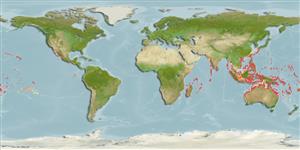Common names from other countries
Environment: milieu / climate zone / depth range / distribution range
Ecologia
marinhas associadas(os) a recifes; intervalo de profundidade 0 - 30 m (Ref. 9710). Tropical; 32°N - 35°S, 24°E - 89°W
Indo-Pacific and Eastern Pacific: East Africa to the Mexico, north to southern Japan and the Hawaiian Islands, south to New Caledonia and the Tuamoto Islands. The subspecies Ostracion meleagris camurum is found in the Hawaiian Islands and Ostracion meleagris clippertonense in the Eastern Pacific. Species replaced by Ostracion cyanurus in Red Sea and Gulf of Aden.
Tamanho / Peso / Idade
Maturity: Lm ? range ? - ? cm
Max length : 25.0 cm TL macho/indeterminado; (Ref. 3141)
Descrição breve
Chaves de identificação | Morfologia | Morfometria
Espinhos dorsais (total) : 0; Raios dorsais moles (total) : 9; Espinhos anais: 0; Raios anais moles: 9. Juveniles and females brown or green with white spots; large males with orange bands and spots on side of body (Ref. 3141). Caudal fin rays 10 (Ref. 3141). Sexually dimorphic (Ref. 37816).
Inhabits clear lagoon and seaward reefs from the lower surge zone to at least 30 meters (Ref. 37816, 48637). Juveniles among rocky boulders, often with long spined urchins, and adults on reef crests and slopes. Males swim about more openly than females that are often in close vicinity to the males (Ref. 48637). Solitary. Feeds on didemnid tunicates, polychaetes, sponges, mollusks, copepods, and algae (Ref. 37816). Minimum depth reported taken from Ref. 128797.
Life cycle and mating behavior
Maturities | Reprodução | Spawnings | Egg(s) | Fecundities | Larvas
Myers, R.F., 1991. Micronesian reef fishes. Second Ed. Coral Graphics, Barrigada, Guam. 298 p. (Ref. 1602)
Categoria na Lista Vermelha da IUCN (Ref. 130435)
CITES (Ref. 128078)
Not Evaluated
Ameaça para o homem
Venomous
Utilização humana
Pescarias: pescarias de subsistência; Aquário: Espécies comerciais
Ferramentas
Relatórios especiais
Descarregue XML
Fontes da internet
Estimates based on models
Preferred temperature (Ref.
115969): 24.6 - 29.3, mean 28.4 (based on 3107 cells).
Phylogenetic diversity index (Ref.
82804): PD
50 = 0.5039 [Uniqueness, from 0.5 = low to 2.0 = high].
Bayesian length-weight: a=0.03548 (0.01700 - 0.07404), b=2.81 (2.62 - 3.00), in cm Total Length, based on LWR estimates for this (Sub)family-body shape (Ref.
93245).
Nível Trófico (Ref.
69278): 2.7 ±0.00 se; based on food items.
Resiliência (Ref.
120179): Elevada, tempo mínimo de duplicação da população menor que 15 meses (Fec assumed to be > 10,000).
Fishing Vulnerability (Ref.
59153): Low vulnerability (15 of 100).
